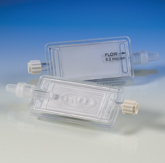Posidyne® ELD Filter
Datasheets
Download:Air-eliminating filter designed for 96-hour particle, bacteria, and endotoxin retention
Features
- Removes particles
- Reduces microorganisms and associated endotoxins
- Eliminates air
- Non-phthalate fluid pathway
- Slim housing profile
Benefits
- Protects patients against particle-related risks
- 96- hour life on filter and set reduces cost of IV therapy and minimizes nursing time and set manipulations
- Minimizes air emboli
- Suitable for paclitaxel delivery
- Simple to tape in place
Filter Media
0.2 µm positively charged Nylon Posidyne membraneFilters and Tubing Extension
Non-phthalate, free of natural rubber latexDimensions (approximate)
Length = 6.9 cmWidth = 3.6 cm
Depth = 0.7 cm
Connectors
Male luer lock outlet and female luer lock inletFilter Housing Volume
Approximately 2 mLApproximate Total Hold-up Volume
| ELD96NT*, ELD96NTE** | 2.0 mL |
| ELD96LLCE** | 2.6 mL |
| ELD96LL* | 2.7 mL |
| ELD96LYL*, ELD96LYLE**, ELD96NY* | 2.8 mL (including volume from Y-site to tubing outlet of 0.3 mL) |
| ELD96NYS* | 4.3 mL (including volume from Y-site to tubing outlet of 1.0 mL) |
| ELD96LYLS*, ELD96LYLSE** | 4.3 mL (including volume from Y-site to tubing outlet of 1.2 mL) |
* Intended for distribution or use in the USA.
** Intended for distribution or use in Europe.
Sterility
Sterile and non-pyrogenic fluid pathwayMaximum Flow Rate
(Tested under gravity with 0.9% saline solution at 1 m head height.)Variants with standard bore extension tubing: approximately 21-23 mL/min
ELD96NYS approximately 35 mL/min
Variants with microbore extension tubing: approximately 13-14 mL/min
ELD96NY approximately 18.5 mL/min
Maximum Working Pressure
1500 mm HG (approximately 30 psi, 2 bar)Usage Specifications
Single patient use up to 96 hoursCan be used with continuous infusions or intermittent infusions/injections
Inadvertent Contamination of Intravenous Infusion Solutions Can Have Serious Consequences
- Particulate contamination arises from a variety of sources, intrinsically in infusates and equipment or extrinsically due to manipulations1. Particles cause phlebitis on peripheral infusion lines and have serious systemic effects, damaging the lung and solid organs by irritation of the endothelium and by deposition in the microvasculature2.
- Microbiological contamination of IV administration systems arises inadvertently due to manipulations3. Some bacteria can grow rapidly in infusion fluids, increasing the infection risk4.
- Endotoxins have serious effects on the inflammatory and coagulation systems. They are released by Gram-negative bacteria and have been shown to penetrate conventional IV filters4. Only filters that retain endotoxins can safely be used for more than 24 hours5.
- Entrained air can arise from infusion solutions degassing, incomplete priming or disconnections. Air can be particularly problematic on central lines, leading to air embolism, which can be fatal6.
References:
- Ball, P.A. (2003) Intravenous in-line filters: filtering the evidence. Curr Opin Clin Nutr Metab Care, 6:319-25.
- Lehr, H.A. et al. (2002) Particulate matter contamination of intravenous antibiotics aggravates loss of functional capillary density in postischemic striated muscle. Am J Respir Crit Care Med, 165:514-20.
- Trautmann, M. et al. (1997) Bacterial colonization and endotoxin contamination of intravenous infusion fluids. J Hosp Infect, 37:225-36.
- Richards, C. & Thomas, P. (1990) Use of endotoxin retentive intravenous filters with pediatric total parenteral nutrition solutions. J Clin Pharm Ther, 15:53-8.
- Richards, C. & Grassby, P.F. (1994) A comparison of the endotoxin-retentive abilities of two '96-h' in-line intravenous filters. J Clin Pharm Ther, 19:199-202.
- Coppa, G.F. et al. (1981) Air embolism: a lethal but preventable complication of subclavian vein catheterization. JPEN J Parenter Enteral Nutr, 5:166-8.
- Muth, C.M. & Shank, E.S. (2000) Gas embolism. N Engl J Med, 342 (7):476-482.
IV Filters
Filtration, Delivery
| Posidyne ELD Filter | |||
| Part Number | Description | Pkg | |
| ELD96LL | With microbore extension tubing (USA only) | 48 units/case | |
| ELD96LLCE | With microbore extension tubing and downstream slide clamp (Europe only) | 50 units/case | |
| ELD96LYL | With microbore extension tubing and Y injection site (USA only) | 48 units/case | |
| ELD96LYLE | With microbore extension tubing, Y injection site, and downstream slide clamp (Europe only) | 50 units/case | |
| ELD96NY | With microbore extension tubing and needleless Y injection site (USA only) | 48 units/case | |
| ELD96LYLS | With standard bore extension tubing and Y injection site (USA only) | 48 units/case | |
| ELD96LYLSE | With standard bore extension tubing, Y injection site, and downstream slide clamp (Europe only) | 50 units/case | |
| ELD96NYS | With standard bore extension tubing and needleless Y injection site (USA only) | 48 units/case | |
| ELD96NT | Without extension tubing (USA only) | 40 units/case | |
| ELD96NTE | Without extension tubing (Europe only) | 40 units/case | |
We appreciate your review of this product. Please login to your account to leave a review.



